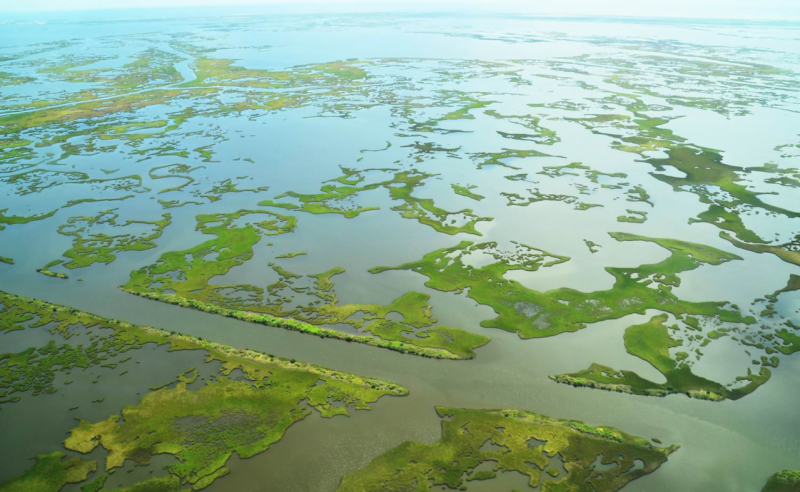In the heart of south-central Louisiana, where the timeless dance of the Mississippi River once nurtured lush wetlands, an ecological crisis is unfolding. Over millennia, the river generously bestowed the Barataria Basin with nutrient-rich mud, acting as a natural guardian against coastal erosion. However, the 20th century witnessed the imposition of dams and levees, disrupting this delicate balance. Today, a relentless combination of sea-level rise and intensifying hurricane seasons threatens the very fabric of the state, leading to a catastrophic loss of land. Since 1932, the Barataria has relinquished 17 percent of its territory, with projections estimating an additional 200-plus square miles disappearing within the next two decades.
In a bold endeavor to combat this environmental peril, Louisiana officials embarked on a groundbreaking initiative on Thursday, signaling the commencement of a $2.92 billion project. This ambitious undertaking aims to divert sediment from the Mississippi River back into the Barataria Basin, emulating the river’s natural flow and striving to salvage the state’s vanishing coast. The project stands as the inaugural step in Louisiana’s grand $50 billion Coastal Master Plan, a visionary strategy funded, in part, by a settlement arising from the ecological catastrophe of the Deepwater Horizon oil spill in 2010.
Understanding the Crisis
To comprehend the gravity of the situation, one must delve into the historical significance of the Barataria Basin. Over thousands of years, the mighty Mississippi River carved a winding path through the basin, depositing invaluable sediment along its course. This natural process not only enriched the soil but also acted as a bulwark against the erosive forces of the sea. However, the advent of 20th-century innovations, specifically dams and levees, disrupted this harmonious relationship.
The consequences have been dire. The once-thriving wetlands of the Barataria Basin, which depended on the replenishing influx of river mud, are now succumbing to the relentless assault of land loss. The delicate equilibrium that sustained this ecosystem for centuries has been disrupted, opening the floodgates to a myriad of environmental challenges.
The Mid-Barataria Sediment Diversion Project
Enter the mid-Barataria Sediment Diversion Project, a monumental initiative designed to reverse the tide of ecological decline. Spearheading this ambitious effort is the Coastal Protection and Restoration Authority of Louisiana, chaired by Bren Haase. At the heart of the project lies a pivotal action – “punching a hole in the levee.” This strategic move will allow the Mississippi River to overflow its banks, mimicking its natural course and channeling sediment back into the basin.
The intricacies of the project involve the installation of a sophisticated gate structure through the Mississippi River’s levee. This gate will serve as a controlled release mechanism, permitting a regulated flow of water into a designated channel. Subsequently, the water will cascade into the Barataria Basin, carrying with it the much-needed mud, silt, and clay – the building blocks of new land.
The Timeline and Anticipated Impact
While the vision is grand, the execution is meticulous. The mid-Barataria Sediment Diversion Project is anticipated to unfold over a five-year construction period. However, the impact is projected to extend far beyond the construction phase. According to Haase, over the course of 50 years, the diversion project aims to add a substantial 21 square miles of land to the Barataria Basin.
Supporters of the project emphasize its potential to restore a degraded ecosystem to some semblance of its former glory. Natalie Snider, associate vice president for the Environmental Defense Fund’s Climate Resilient Coasts and Watersheds program, underscores the urgency of the situation. “There are large areas of open water where the marsh has just eroded and sunk away,” she remarks. The diversion project, in her view, presents a unique opportunity to rejuvenate these areas and reintroduce vitality to a struggling ecosystem.
Challenges and Skepticism
Yet, amid the optimism, concerns loom large. Detractors of the project raise valid questions about its potential impact on existing wildlife in the basin. The delicate balance of the ecosystem, already teetering on the brink, could face further disruption during and after the implementation of the diversion. Furthermore, skepticism persists regarding the extended timeline required for the project to yield tangible results. In a world where environmental challenges demand swift action, a project spanning decades raises legitimate concerns about its efficacy and adaptability to the rapidly changing climate.
Environmental Stewardship and the Human Factor
As Louisiana charts its course towards a sustainable future, the mid-Barataria Sediment Diversion Project stands as a testament to human ingenuity and determination. The state is grappling with the complex interplay between environmental stewardship and human intervention. The delicate dance between nature’s forces and human innovation must be orchestrated with precision to ensure a harmonious coexistence.
The road ahead may be challenging, but as the sediment flows and new land emerges, there is hope that Louisiana’s disappearing coast can be reclaimed. Beyond the ecological implications, the project holds significant economic and social ramifications. The Barataria Basin, once a vibrant ecosystem intertwined with the livelihoods of local communities, can regain its vitality.
Conclusion:
In conclusion, the mid-Barataria Sediment Diversion Project signifies a beacon of hope in the face of environmental adversity. Louisiana, with its visionary Coastal Master Plan, is taking bold strides to not only protect its natural heritage but also to restore the delicate balance that once defined the Barataria Basin. While challenges and concerns persist, the need for proactive measures to combat land loss and environmental degradation cannot be overstated.
As the construction progresses and the sediment diversion takes effect, the eyes of the nation turn towards the resilient spirit of Louisiana. In the unfolding chapters of this ecological saga, there is an opportunity for other regions facing similar challenges to draw inspiration and chart their own paths toward a sustainable future. The mid-Barataria Sediment Diversion Project is more than a construction endeavor; it is a testament to humanity’s commitment to preserving the beauty and resilience of our planet for generations to come.

